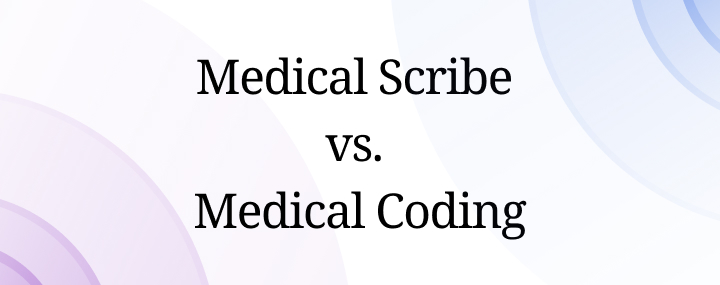Documentation and Administrative Tasks?
Delving into the core of their functions, we shall embark on a journey to discern their unique characteristics. Moreover, we will compare and contrast these professions, analyzing their potential collaboration and synergy within healthcare teams. By exploring these roles, we aim to foster a deeper understanding of their significance in the ever-evolving healthcare landscape.

A medical scribe is a person who accompanies a physician or other healthcare provider during patient encounters and documents the clinical information in real-time using an electronic health record (EHR) system. A medical scribe can also perform other tasks, such as retrieving lab results, scheduling appointments, and preparing charts for review.
The main role of a medical scribe is to reduce the administrative burden on the physician or provider and allow them to focus more on the patient's care. A medical scribe can help with the following tasks:
| Task | Description |
|---|---|
Documenting | Documenting the patient’s history, physical examination, diagnosis, treatment plan, prescriptions, referrals, and follow-up instructions |
Capturing | Capturing the physician’s or provider’s verbal orders and dictations |
Entering | Entering orders and charges into the EHR system |
Updating | Updating the patient’s problem list, medication list, allergy list, and immunization record |
Facilitating | Facilitating communication between the physician or provider and other staff members, such as nurses, pharmacists, radiologists, and specialists |
Ensuring | Ensuring the accuracy and completeness of the documentation |
Maintaining | Maintaining confidentiality and compliance with HIPAA and other regulations
|
Having a medical scribe can benefit the physician or provider, the patient, and the healthcare organization. Some of these benefits are:
Improved efficiency and productivity: A medical scribe can save time for the physician or provider by taking care of the documentation and clerical tasks. This can lead to several benefits, such as increasing the number of patients seen daily, reducing errors and omissions, and enhancing billing and coding accuracy. According to a study conducted by researchers from the Kaiser Permanente integrated healthcare organization, using scribes resulted in a lower physician documentation burden and improved efficiency, workflow, and patient-physician interaction. Another study in Australia showed that using scribes improved emergency physicians' productivity, particularly during primary consultations, and decreased patients' emergency department length of stay.
Enhanced quality and safety: Ensuring that the documentation reflects the clinical decision-making process, supports evidence-based practice, and meets regulatory standards, a medical scribe can improve the quality and safety of patient care. A medical scribe can also assist the physician or provider by alerting them to potential issues or discrepancies in the patient’s record or care plan.
Increased satisfaction and engagement: The physician and the patient can experience higher satisfaction and engagement when a medical scribe takes care of the documentation. The physician or provider can focus more on face-to-face interaction with the patient, reducing stress and burnout. They can also have more autonomy and control over their workflow and more opportunities for professional development. The patient can receive more attention and education from the physician or provider, improving their understanding of their condition and treatment options. They can also build trust and rapport with the physician and become more involved in their care.

Medical coding translates clinical information into standardized codes that represent diagnoses, procedures, services, supplies, equipment, drugs, modifiers, and other relevant data. Medical coding is essential for billing, reimbursement, reporting, analysis, research, quality improvement, compliance, and other purposes.
The main role of a medical coder is to ensure that the codes assigned to each patient encounter are accurate, complete, consistent, and compliant with various rules and guidelines. A medical coder can perform the following tasks:
| Task | Description |
|---|---|
Reviewing | Reviewing the patient’s record and extracting the pertinent information |
Assigning | Assigning codes to each diagnosis, procedure, service, consumable, equipment, drug, modifier, etc., using various coding systems such as ICD-10-CM/PCS1, CPT, HCPCS, etc. |
Verifying | Verifying the codes with the documentation and resolving any discrepancies or queries |
Applying | Applying modifiers to adjust or clarify the codes when necessary |
Sequencing | Sequencing the codes according to their importance or specificity |
Checking | Checking for errors or missing information |
Submitting | Submitting the coded data to the billing department or clearinghouse |
Keeping up to date | Keeping up to date with coding changes and updates |
Accurate medical coding is vital for many reasons. Some of these reasons are:
Ensuring proper reimbursement: Accurate medical coding is essential to avoid under- or over-charging that may result in lost revenue or denied claims. Medical coding also helps to support appropriate payment adjustments based on various factors, such as severity of illness, risk adjustment, quality measures, etc.
Facilitating communication: Communication between different healthcare entities, such as providers, payers, regulators, researchers, etc., can be facilitated by medical coding. Medical coding can also enable data sharing and interoperability among different EHR systems and platforms.
Supporting decision-making: Medical coding can support decision-making at various healthcare system levels. Medical coding can provide valuable insights into the prevalence, trends, outcomes, costs, and quality of care for different diseases, procedures, services, populations, etc. Medical coding can also inform policy-making, resource allocation, performance evaluation, and improvement initiatives.

Medical scribe and medical coding are distinct but related roles in the healthcare industry. They have different functions and duties, as well as different skills and training requirements. They also have different impacts on efficiency and patient care. Here are some of the key differences between medical scribe and medical coding:
A medical scribe works directly with the physician or provider during patient encounters. It documents the clinical information in real-time using an EHR system. In contrast, a medical coder works independently after the patient encounter and assigns codes to the clinical information using various coding systems and tools.
To be a medical scribe, one must possess excellent listening, typing, communication, and interpersonal skills. These skills are essential for capturing clinical information accurately and efficiently and interacting with the physician or provider and the patient. One also needs to have a basic knowledge of medical terminology, anatomy, physiology, pharmacology, etc., to understand the medical concepts and terms used in the patient encounter. A medical scribe usually requires a high school diploma or equivalent and a certification or training program from an accredited institution.
To be a medical coder, one must have strong analytical, problem-solving, attention to detail, and computer skills. These skills are vital for assigning codes to the clinical information correctly and consistently, as well as for using various coding systems and tools effectively. One must also have a comprehensive knowledge of medical terminology, anatomy, physiology, pharmacology, pathophysiology, etc., and various coding systems, rules, and guidelines to code the clinical information according to the standards and regulations. A postsecondary certificate or associate degree from an accredited institution and a certification from a recognized organization is typically required for a medical coder.
Reducing the administrative burden on the physician or provider and allowing them to focus more on patient care are ways a medical scribe can improve efficiency and patient care. A medical scribe can also enhance the quality and safety of the documentation by ensuring that it reflects the clinical decision-making process and meets regulatory standards. Additionally, a medical scribe can facilitate communication between the physician or provider and other staff members by acting as a liaison and a coordinator.
Ensuring proper reimbursement for the services rendered and facilitating communication between different healthcare entities are ways a medical coder can improve efficiency and patient care. A medical coder can also support decision-making at various healthcare system levels by providing valuable data and insights into the prevalence, trends, outcomes, costs, and quality of care for different diseases, procedures, services, populations, etc. A medical coder can also inform policy-making, resource allocation, performance evaluation, and improvement initiatives using various coding systems and tools.
Medical scribes and medical coders are not mutually exclusive roles. They can collaborate and synergize in healthcare teams to achieve optimal results. Here are some of the ways that scribes and coders can help each other:
A medical scribe can help a medical coder by providing clear, complete, accurate, and timely documentation that supports the coding process. A medical scribe can also use standardized templates or formats that facilitate coding. A medical scribe can also communicate with the coder to clarify any questions or issues regarding the documentation or coding.
A medical coder can help a medical scribe by providing feedback on documentation quality and accuracy. A medical coder can also educate the scribe on the coding systems, rules, and guidelines for their specialty or setting. A medical coder can also communicate with the scribe to resolve discrepancies or queries regarding the documentation or coding.
Medical scribe and medical coding are two important roles in the healthcare industry with different but complementary functions. They contribute to efficiency, quality, safety, communication, decision-making, reimbursement, and compliance in healthcare settings. They both require specific skills and training that match their duties and responsibilities. They both have benefits and challenges that affect their performance and satisfaction. They both can collaborate and synergize in healthcare teams to achieve optimal results.
In this analysis, we have explored the invaluable advantages of incorporating a Medical Scribe into the workflow of physicians and medical facilities, identifying key aspects that enhance their effectiveness. Continuing our exploration, it is essential to acknowledge the emergence of cutting-edge tools like Tali, leveraging the prowess of artificial intelligence to elevate the Medical Scribe process and patient care. Through the implementation of such advanced technologies, this process experiences remarkable improvements in both speed and accuracy, signifying a promising leap forward in medical documentation and overall healthcare efficiency.
Tali is an AI medical scribe that helps you document your patient encounters with ease and accuracy. Tali listens to your conversations with your patients and automatically transcribes them into structured notes you can review and edit. Tali also integrates with your EHR system and can populate the relevant fields with the information extracted from the audio. Tali saves you time, reduces errors, and improves your workflow.
With Tali, you can focus more on your patients and less on paperwork. You can also use Tali to access clinical information, such as lab results, medications, and guidelines, by simply asking Tali a question. Tali is a smart and reliable assistant who supports you in providing quality patient care.
If you want to experience the benefits of Tali, you can try it for free now.
A medical scribe is a healthcare professional who accompanies physicians during patient encounters and documents clinical information in real-time using an electronic health record (EHR) system. They also assist with tasks like retrieving lab results and scheduling appointments. The primary role of a medical scribe is to reduce the administrative burden on physicians, enabling them to focus more on patient care. Their responsibilities include documenting patient history, physical examinations, diagnoses, treatment plans, and more. They also maintain accuracy and compliance with regulations like HIPAA.
Medical coding involves translating clinical information into standardized codes that represent diagnoses, procedures, services, and other relevant data. These codes are crucial for billing, reimbursement, reporting, analysis, research, compliance, and quality improvement. Medical coders review patient records, assign appropriate codes, verify coding accuracy, and sequence codes according to their importance. Accurate medical coding ensures proper reimbursement, facilitates communication between healthcare entities, and supports decision-making at various levels within the healthcare system.
Medical scribes and medical coders have distinct roles. A medical scribe documents patient encounters in real-time, improving efficiency, quality, and communication within healthcare settings. On the other hand, medical coders translate clinical information into standardized codes, enhancing billing accuracy, data sharing, and decision-making. While their functions differ, they can collaborate to enhance patient care. Medical scribes can provide clear documentation to assist coders, and coders can offer feedback and education to scribes. Collaborative efforts between these roles can optimize healthcare processes and outcomes.